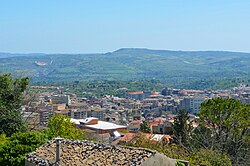Palazzolo Acreide: Difference between revisions
Extended confirmed users 3,268 edits m chrono order notable people |
Rescuing 2 sources and tagging 0 as dead. #IABot (v1.6.1) (Balon Greyjoy) |
||
| Line 96: | Line 96: | ||
* [http://www.palazzolo-acreide.it/ Official website] {{it icon}} |
* [http://www.palazzolo-acreide.it/ Official website] {{it icon}} |
||
* [http://www.valdinoto.com/english/palazzolo_acreide.htm Sites about the city] {{en icon}} |
* [http://www.valdinoto.com/english/palazzolo_acreide.htm Sites about the city] {{en icon}} |
||
* [http://www.sanpaolopalazzolo.org/ Saint Paul] {{it icon}} |
* [https://web.archive.org/web/20060628195651/http://www.sanpaolopalazzolo.org/ Saint Paul] {{it icon}} |
||
* [http://www.palermoweb.com/cittadelsole/sicilytour/english/palazzolo_acreide_en.htm Ancient Ruins] {{en icon}} |
* [http://www.palermoweb.com/cittadelsole/sicilytour/english/palazzolo_acreide_en.htm Ancient Ruins] {{en icon}} |
||
* [http://www.sitiunesco.it/index.phtml?id=700 UNESCO World Heritage Sites] {{en icon}} |
* [https://web.archive.org/web/20051102050139/http://www.sitiunesco.it/index.phtml?id=700 UNESCO World Heritage Sites] {{en icon}} |
||
* [http://www.regione.sicilia.it/TURISMO/Web_turismo/uk/localita/SR/palazzolo/homepage.html Tourist Attractions and History] {{en icon}} |
* [http://www.regione.sicilia.it/TURISMO/Web_turismo/uk/localita/SR/palazzolo/homepage.html Tourist Attractions and History] {{en icon}} |
||
* [http://www.globopix.net/fotografie/palazzoloacreide_1.html Image gallery]<!--DON'T REMOVE, PLEASE. NEEDS IT AS PER AGREEMENT TO USE THE IMAGE Palazzolo San Sebastiano.JPG--> {{it icon}} |
* [http://www.globopix.net/fotografie/palazzoloacreide_1.html Image gallery]<!--DON'T REMOVE, PLEASE. NEEDS IT AS PER AGREEMENT TO USE THE IMAGE Palazzolo San Sebastiano.JPG--> {{it icon}} |
||
Revision as of 02:45, 4 December 2017
Palazzolo Acreide | |
|---|---|
| Comune di Palazzolo Acreide | |
 View of the town from the acropolis of ancient Akrai | |
St. Paul | |
| Saint day | June 29 |
| Website | Official website |
Palazzolo Acreide (
History
The area around Palazzolo Acreide has been inhabited since ancient times. In the 10th-11th centuries B.C.E, the
In the treaty between the Romans and Hiero II of Syracuse in 263 BC it was assigned to the latter. After the Roman conquest, it became a civitas stipendiaria, and was still prospering in the course of the early Christian age.
The old city was probably destroyed by the
Ancient city
The Ancient City lies on the hill above the modern town, the approach to it being defended by quarries, in which tombs of all periods have been discovered. The auditorium of the small theatre is well-preserved, though nothing of the stage remains. Nearby are the ruins of other buildings, which bear, without justification, the names Naumachia, Odeum (perhaps a bath establishment) and Palace of Hiero. The water supply was obtained by subterranean aqueducts. In the cliffs of the Monte Pineta to the south are other burial niches, and curious bas-reliefs called Santoni or Santicelli, carved in the 19th century by a peasant proprietor, which also appear to be related to funeral ceremonies. Also nearby is the necropolis of the Acrocoro della Torre, where many sarcophagi have been found. About 5 miles (8 km) north lies Buscemi, near which a sacred grotto has been discovered; and also a church cut into the rock and surrounded by a cemetery.
| UNESCO World Heritage Site | |
|---|---|
| Criteria | Cultural: i, ii, iv, v |
| Reference | 398 |
| Inscription | 2002 (20th Session) |
Economy
The economy of Palazzolo Acreide relies mainly on agriculture (cereals) and farming of cattle and sheep. The population in 2009 was approximately 9,000, growing to 15,000 by 2016.[citation needed]
Main sights
- Church of St. Sebastian(15th century, rebuilt after the 17th century).
- Basilica of San Paolo (18th century).
- Church of Santa Maria della Medaglia.
- Church of San Michele (15th to 16th centuries, rebuilt after 1693). It is a typical example of "minor Sicilian Baroque", with a notable belfry covered by a cupola.
- Church of the Assunta or Immacolata (18th century). It has a convex façade and a single nave interior, with rich decorations. It houses a statue of the Madonna, in Carrara white marble, sculpted by Francesco Laurana in 1471–72.
- Church of St. Anthony (18th century), unfinished, with a neo-Romanesque façade.
- The Chiesa Madre ("Mother Church"). The first document attesting its existence dates from 1215, when the church was dedicated to St. Nicholas. It was largely rebuilt and redecorated after the earthquake of 1693, with a Neo-classicist façade. The interior is on the Latin cross plan, with a nave and two aisles decorated with precious polychrome marbles.
- Antonino Uccello's Museum House. It houses artifacts and remains from the peasant civilization of Sicily, including working tools, glass paintings, wax statues and others.
- Palazzo Cappellani, where the Archaeological Museum is located (soon to be opened).
- Grotto of St. Conrad, a small church carved in a cliff, on the site where the hermit Corrado Confalonieri retired in the 14th century. Traces of mosaics and the base of the altar remain.
- "Il Teatro Greco di Akrai" (Ancient Greek theater)

The Greek theater of ancient Akrai
Personalities
- Francesco Carpino (1905 - 1993), cardinal
- Turi Golino (1920-2000), trumpeter and composer
- Antonio Uccello (1922 - 1979), poet and anthropologist
- Giuseppe Fava (1925 - 1984), investigative journalist, playwright, essayist and antimafia activist who ultimately was murdered by the Sicilian Mafia.
- Carlo Gaetano Giuliano (1929-), politician
- Silvia Salemi (1978-), singer
References
- ^ "Superficie di Comuni Province e Regioni italiane al 9 ottobre 2011". Italian National Institute of Statistics. Retrieved 16 March 2019.
- ISTAT
- ^ "Popolazione Residente al 1° Gennaio 2018". Italian National Institute of Statistics. Retrieved 16 March 2019.


